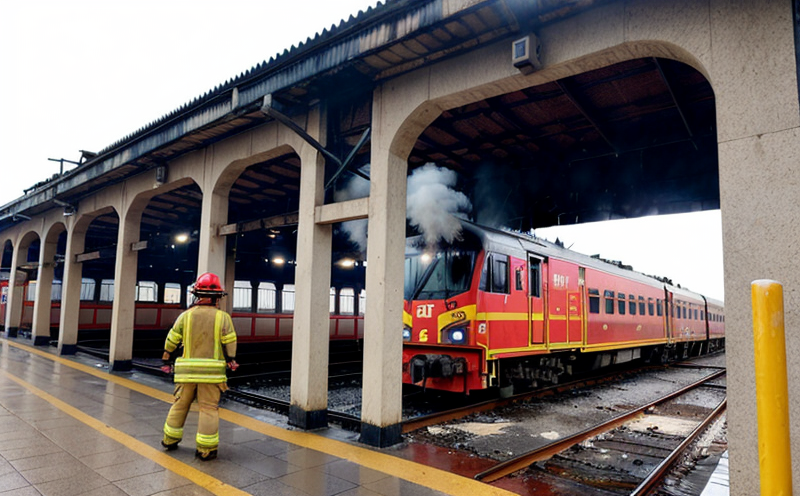Railway station fire safety inspection
The railway industry plays a critical role in modern transportation, connecting millions of passengers daily and ensuring safe travel. Fire safety is paramount to maintaining this essential service, as fires can lead to severe consequences including loss of life, property damage, and disruption to public transport networks. Therefore, regular inspections are crucial for identifying potential risks and ensuring that fire safety systems meet the highest international standards.
The inspection process involves multiple steps designed to comprehensively evaluate various aspects of railway station fire safety. This includes assessing fire detection and suppression systems, emergency lighting, smoke control measures, evacuation routes, and access controls. These inspections are not merely compliance exercises; they serve a dual purpose: ensuring operational reliability and reducing the risk of fires.
At our laboratory, we use state-of-the-art equipment to perform these inspections according to international standards such as ISO 9001, ISO 17025, and AS/NZS 3808. Our team comprises experienced fire safety engineers who specialize in railway applications, ensuring that all aspects of the inspection are covered comprehensively.
One key focus is on the integrity and functionality of fire detection systems. These systems include smoke detectors, heat sensors, and optical flame detectors installed throughout the station. Proper calibration and maintenance are essential to ensure these devices can accurately detect fires at their earliest stages.
The inspection process also encompasses the evaluation of suppression systems like sprinklers and gas extinguishing systems. We examine these components for proper installation, connection integrity, and readiness for use in emergencies. Additionally, we check that these systems are connected to reliable power sources and have adequate water supplies or fire-extinguishing agent reserves.
Emergency lighting is another critical component of railway station fire safety inspections. We assess the location, type, and functionality of emergency lights, ensuring they provide sufficient illumination for safe evacuation in case of a fire. The placement and visibility of these lights are vital to guiding passengers through the safest exit routes.
Smoke control measures are also evaluated rigorously during our inspections. These systems are designed to prevent smoke from spreading throughout the station, allowing firefighters easier access to the affected areas and protecting non-affected zones. We verify that these systems operate correctly under simulated fire conditions, ensuring they effectively contain and manage smoke within designated containment areas.
Evacuation routes form a significant part of our inspection process. We check for clear signage indicating exit points, ensure that doors and gates are not obstructed or locked during emergencies, and assess the functionality of any mechanical aids used to assist passengers in exiting the station safely. Compliance with relevant fire codes is strictly enforced.
Access controls play a critical role in maintaining security during normal operations while also facilitating rapid evacuation procedures during emergencies. We examine these systems for proper operation, ensuring they can be overridden when necessary and do not impede emergency responses.
The inspection process requires meticulous attention to detail, as any oversight could have severe consequences. By adhering strictly to international standards and leveraging our expertise in railway fire safety, we ensure that each station is equipped with the best possible fire protection systems. This approach helps maintain public confidence in the safety of rail travel while also mitigating potential risks.
Our comprehensive approach to railway station fire safety inspections guarantees adherence to high-quality benchmarks. We employ advanced testing methods and rigorous evaluation criteria to identify any deficiencies or areas for improvement, providing actionable recommendations to enhance overall fire safety performance.
Applied Standards
- ISO 9001: Quality Management Systems
- ISO 17025: Conformity Assessment – General Requirements for the Competence of Testing and Calibration Laboratories
- AS/NZS 3808: Fire Safety Engineering
- EN 12697-1: Part 1 of EN 12697 Series – Design and Installation of Sprinkler Systems for Industrial, Commercial and Other Occupancies Including Buildings with a High Risk of Fire
- ASTM E1043-18: Standard Practice for Inspection of Fire Protection Systems in Buildings
- NFPA 72: National Fire Alarm and Signaling Code
- IEC 62567: Railways – Interoperability for Signal and Train Control Systems
Our inspections are conducted in accordance with these internationally recognized standards, ensuring that the fire safety systems at railway stations meet the highest levels of reliability and performance.
Environmental and Sustainability Contributions
- Emission Reduction: By identifying and rectifying potential fire hazards early, we help prevent fires which can significantly reduce harmful emissions into the environment. Properly functioning fire suppression systems minimize the spread of flames, thus reducing the need for extensive firefighting operations.
- Energy Efficiency: Ensuring that fire safety systems are properly maintained helps to optimize energy consumption within railway stations. For instance, efficient fire alarms and extinguishing agents can reduce the amount of electricity and resources required during emergencies.
- Resource Conservation: Regular inspections contribute to the conservation of critical resources by preventing waste through early detection and resolution of issues before they escalate into full-blown fires. This proactive approach helps in maintaining infrastructure integrity without unnecessary replacements or repairs.
Through our diligent fire safety inspections, we play a vital role in promoting sustainability within railway operations while enhancing public safety.
Use Cases and Application Examples
The application of our railway station fire safety inspection services extends across various scenarios, including new construction projects, existing facility upgrades, and routine maintenance checks. Here are some specific use cases:
- New Construction Projects: Our inspections ensure that all newly built stations meet the latest fire safety standards right from the start.
- Facility Upgrades: Older stations undergo modifications to incorporate modern fire protection technology, enhancing their overall safety profile.
- Routine Maintenance Checks: Regular inspections help maintain existing systems in optimal condition, ensuring they remain effective throughout their lifecycle.
In each case, our team works closely with stakeholders to identify specific needs and implement tailored solutions. This collaborative approach ensures that all fire safety requirements are comprehensively addressed.





